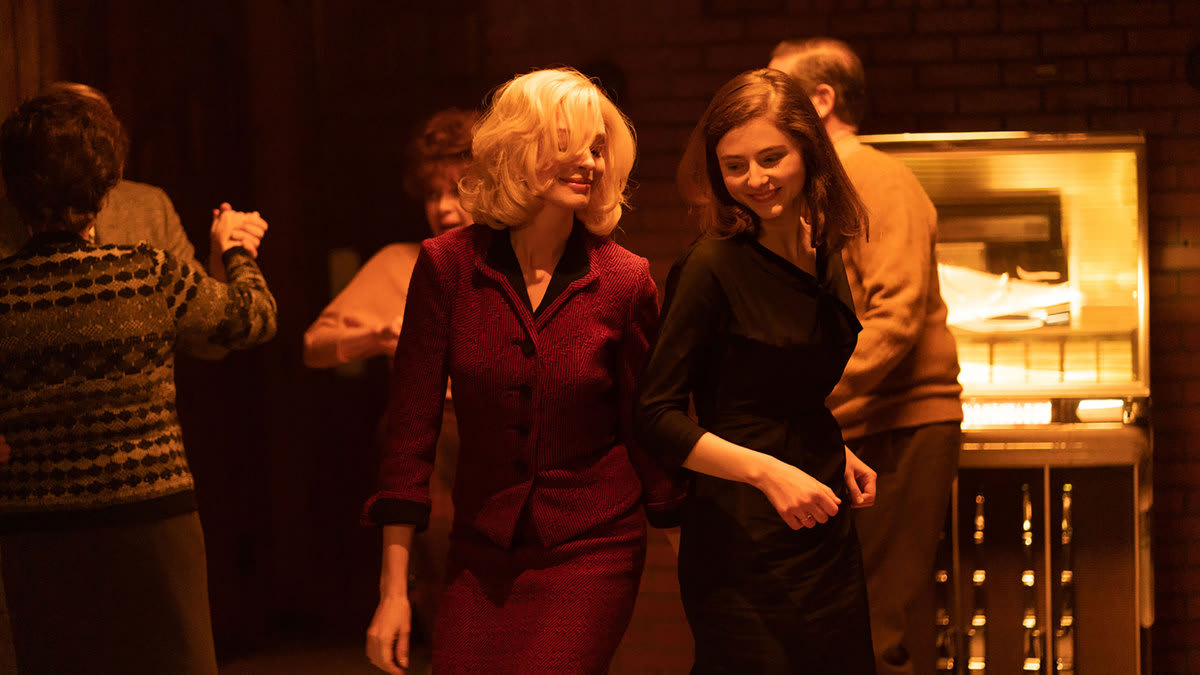Eileen’s first image is through a car windshield as the vehicle’s interior fills with smoke. Consider that haze a multifaceted metaphor—for pent-up desire, lethal suffocation, and liberating concealment—as well as a potential case of the Chekhov gun principle.
That said, a real firearm also plays a part in William Oldroyd’s adaptation of Otessa Moshfegh’s book of the same name, which premiered Friday at the Sundance Film Festival. The film interweaves elements from his prior Lady Macbeth, Todd Haynes’ Carol, Edgar Wright’s Last Night in Soho and various 1940s noirs and 1950s melodramas into something sultry, sinister, and wholly surprising.
In snowy 1960s Boston at Christmas, 24-year-old Eileen (Thomasin McKenzie) works at a prison for boys, where her primary duties are patting down the women who come to visit their sons and suffering the withering scorn of her boss (Siobhan Fallon Hogan). Eileen has a stern, placid countenance but eyes that are far from dull. As she moves through the hallways of her place of employment, her gaze is keen, critical and—when it comes to a handsome guard as well as a particular inmate whom she watches in the yard—covetous.
This is a young woman with barely controllable carnal urges, further evidenced by her habit of parking a lover’s lane-style spot near the wintery beach so she can pleasure herself while spying on couples making out, and then cool herself off with a fistful of snow to the crotch.

Photo by Matt Winkelmeyer/Getty Images
Eileen is hot to trot but with no outlet for her lust; instead, she spends her days and nights driving to and from the prison in a beat-up car that uncontrollably fumes, thereby requiring her to keep her windows perpetually rolled down. Her only other recurring pitstop is the liquor store so she can replenish the booze consumed by her father (Shea Whigham), a former cop who lost his job due to some ill-defined combination of alcoholism and volatility.
With the family matriarch dead and another daughter married and living out of her father’s reach, Eileen is the de facto lady of the house. It’s not, to put it mildly, a position she adores, since her pops is a nasty bastard, whether semi-sober or fully sloshed. He menaces the neighborhood to the point of becoming a recurring problem for local cop Buck (Yellowstone’s Jefferson White), and cruelly telling his kid that she’s one of the world’s many nobodies.
Oldroyd sets his scene with bleak hues, period-piece pop and R&B songs, and a score that feels like an ominous marriage of Bernard Herrmann and Frank Skinner—not to mention bold title cards that would be right at home introducing a Douglas Sirk film. It’s a drab milieu with sex and violence lurking just beneath the surface. Both begin bubbling up with the arrival of Dr. Rebecca Saint John (Anne Hathaway), a Harvard-trained bleach-blonde physician in high heels, a snappy little hat, and a cigarette perched defiantly, intoxicatingly, between her lips.
From the moment Rebecca pulls up in her red convertible, and then corrects the man presenting her to the staff with a self-assured smile that cuts like a knife, Eileen is entranced. Moreover, Rebecca realizes it and, looking for a friend in this new town, she strikes up a conversation with Eileen. Shortly thereafter, she invites her out for a drink at the only bar in town.
Thrilled by this offer, Eileen shows up in her mother’s dress and fetching make-up, but she’s still unprepared for the magnetic glamor, sensuality, and confidence of Rebecca, which doesn’t just sweep Eileen off her feet—it practically blows her away.
Hathaway is dazzling in these early passages. Her larger-than-life poise and cool invigorates Eileen, just as it wows the film’s title character. Eileen goes wide-eyed with delight from a pat on the knee and practically swoons when the doctor takes her out onto the dance floor, damn the looks from the watering hole’s toothless, charmless male customers. Eileen’s infatuation with Rebecca isn’t without its consequences, however; following her inebriated trip home, she suffers the wrath of her devout dad, and it’s not long before she’s gaining a reputation as another of her clan’s bad apples.

Matt Winkelmeyer/Getty Images
Nestled into Eileen is the story of Lee Polk (Sam Nivola), a prison inmate facing a murder charge for brutally slaying his father in bed. Eileen’s initial interest in the patricidal boy seems partly inspired by her own fantasies about killing her dad, which Whigham’s bastard tauntingly discusses with her, and which Oldroyd amusingly dramatizes without warning.
Rebecca’s curiosity about Lee results in a meeting with his mom (Marin Ireland), and it’s that thread which begets the film’s abrupt detour into more harrowing Tarantino-esque territory. There’s no way to discuss that right-turn without spoiling the proceedings. What can be said, though, is that Ireland nearly steals the show during her one big scene, segueing brilliantly from feral fury, to despondent contrition and pitiable resignation, to panic and terror.
Ireland shines brightly in her scant screen time, providing fantastic support for her leading-lady co-stars. Hathaway’s radiant charisma is laced with a subtle tinge of bitterness and hostility, the better to cast Rebecca’s cocksure attitude and against-the-grain ethos as middle fingers to a patriarchal establishment that only sees or cares about her beauty.
Eileen is the meek and needy flipside to Rebecca, if also a woman with a not-inconsiderable amount of rage, strength and ruthlessness ready to burst free from within. McKenzie captures her protagonist’s inner tumult with minimal expressiveness; right up to the thorny finale—which may be less clear cut than it seems—she conveys Eileen’s complicated emotional and psychological state through stillness and silence.
Oldroyd magnifies his action’s oppressive atmosphere via meticulously staged visuals; his use of constricting corridors, doorways, windows and mirrors articulate all that isn’t spoken aloud. While there are times when his stylization threatens to veer into noir pantomime, the director flatters far more than he imitates, and his stewardship is as icy as his story’s passions are fiery. With Eileen, he pulls off a unique and bracing switcharoo, in the process giving audiences multiple intertwined genres for the price of one.
Keep obsessing! Sign up for the Daily Beast’s Obsessed newsletter and follow us on Facebook, Twitter, Instagram and TikTok.
This post originally appeared on and written by:
Nick Schager
The Daily Beast 2023-01-22 07:33:00

